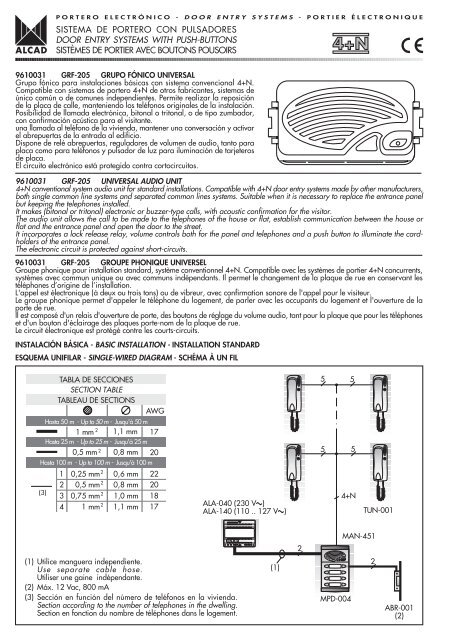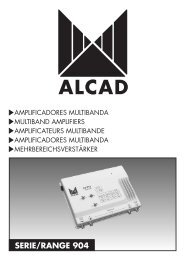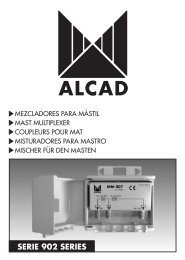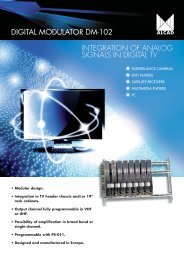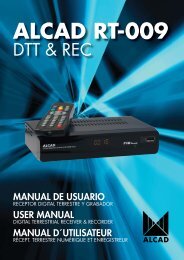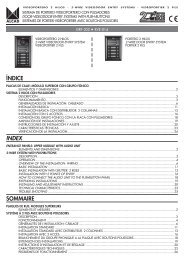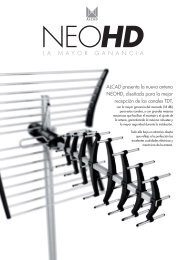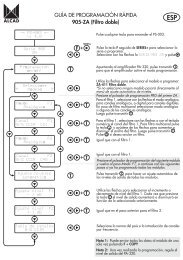sistema de portero con pulsadores door entry systems with ... - Alcad
sistema de portero con pulsadores door entry systems with ... - Alcad
sistema de portero con pulsadores door entry systems with ... - Alcad
- No tags were found...
Create successful ePaper yourself
Turn your PDF publications into a flip-book with our unique Google optimized e-Paper software.
PORTERO ELECTRÓNICO - DOOR ENTRY SYSTEMS - PORTIER ÉLECTRONIQUESISTEMA DE PORTERO CON PULSADORESDOOR ENTRY SYSTEMS WITH PUSH-BUTTONSSISTÈMES DE PORTIER AVEC BOUTONS POUSOIRS9610031 GRF-205 GRUPO FÓNICO UNIVERSALGrupo fónico para instalaciones básicas <strong>con</strong> <strong>sistema</strong> <strong>con</strong>vencional 4+N.Compatible <strong>con</strong> <strong>sistema</strong>s <strong>de</strong> <strong>portero</strong> 4+N <strong>de</strong> otros fabricantes, <strong>sistema</strong>s <strong>de</strong>único común o <strong>de</strong> comunes in<strong>de</strong>pendientes. Permite realizar la reposición<strong>de</strong> la placa <strong>de</strong> calle, manteniendo los teléfonos originales <strong>de</strong> la instalación.Posibilidad <strong>de</strong> llamada electrónica, bitonal o tritonal, o <strong>de</strong> tipo zumbador,<strong>con</strong> <strong>con</strong>firmación acústica para el visitante.una llamada al teléfono <strong>de</strong> la vivienda, mantener una <strong>con</strong>versación y activarel abrepuertas <strong>de</strong> la entrada al edificio.Dispone <strong>de</strong> relé abrepuertas, reguladores <strong>de</strong> volumen <strong>de</strong> audio, tanto paraplaca como para teléfonos y pulsador <strong>de</strong> luz para iluminación <strong>de</strong> tarjeteros<strong>de</strong> placa.El circuito electrónico está protegido <strong>con</strong>tra cortocircuitos.9610031 GRF-205 UNIVERSAL AUDIO UNIT4+N <strong>con</strong>ventional system audio unit for standard installations. Compatible <strong>with</strong> 4+N <strong>door</strong> <strong>entry</strong> <strong>systems</strong> ma<strong>de</strong> by other manufacturers,both single common line <strong>systems</strong> and separated common lines <strong>systems</strong>. Suitable when it is necessary to replace the entrance panelbut keeping the telephones installed.It makes (bitonal or tritonal) electronic or buzzer-type calls, <strong>with</strong> acoustic <strong>con</strong>firmation for the visitor.The audio unit allows the call to be ma<strong>de</strong> to the telephones of the house or flat, establish communication between the house orflat and the entrance panel and open the <strong>door</strong> to the street.It incorporates a lock release relay, volume <strong>con</strong>trols both for the panel and telephones and a push button to illuminate the cardhol<strong>de</strong>rsof the entrance panel.The electronic circuit is protected against short-circuits.9610031 GRF-205 GROUPE PHONIQUE UNIVERSELGroupe phonique pour installation standard, système <strong>con</strong>ventionnel 4+N. Compatible avec les systèmes <strong>de</strong> portier 4+N <strong>con</strong>currents,systèmes avec commun unique ou avec communs indépendants. Il permet le changement <strong>de</strong> la plaque <strong>de</strong> rue en <strong>con</strong>servant lestéléphones d’origine <strong>de</strong> l’installation.L'appel est électronique (à <strong>de</strong>ux ou trois tons) ou <strong>de</strong> vibreur, avec <strong>con</strong>firmation sonore <strong>de</strong> l'appel pour le visiteur.Le groupe phonique permet d'appeler le téléphone du logement, <strong>de</strong> parler avec les occupants du logement et l'ouverture <strong>de</strong> laporte <strong>de</strong> rue.Il est composé d'un relais d'ouverture <strong>de</strong> porte, <strong>de</strong>s boutons <strong>de</strong> réglage du volume audio, tant pour la plaque que pour les téléphoneset d'un bouton d'éclairage <strong>de</strong>s plaques porte-nom <strong>de</strong> la plaque <strong>de</strong> rue.Le circuit électronique est protégé <strong>con</strong>tre les courts-circuits.INSTALACIÓN BÁSICA - BASIC INSTALLATION - INSTALLATION STANDARDESQUEMA UNIFILAR - SINGLE-WIRED DIAGRAM - SCHÉMA À UN FILTABLA DE SECCIONESSECTION TABLETABLEAU DE SECTIONSAWGHasta 50 m - Up to 50 m - Jusqu'à 50 m1 mm 2 1,1 mm 17Hasta 25 m - Up to 25 m - Jusqu'à 25 m0,5 mm 2 0,8 mm 20Hasta 100 m - Up to 100 m - Jusqu'à 100 m(3)12340,25 mm 2 0,6 mm 220,5 mm 2 0,8 mm 200,75 mm 2 1,0 mm 181 mm 2 1,1 mm 17ALA-040 (230 V )ALA-140 (110 .. 127 V )5 55 54+NTUN-001230 V V2MAN-451(1) Utilice manguera in<strong>de</strong>pendiente.Use separate cable hose.Utiliser une gaine indépendante.(2) Máx. 12 Vac, 800 mA(3) Sección en función <strong>de</strong>l número <strong>de</strong> teléfonos en la vivienda.Section according to the number of telephones in the dwelling.Section en fonction du nombre <strong>de</strong> téléphones dans le logement.(1)MPD-0042ABR-001(2)
PORTERO ELECTRÓNICO - DOOR ENTRY SYSTEMS - PORTIER ÉLECTRONIQUEINSTRUCCIONES DE CONEXIÓN - CONNECTION INSTRUCTIONS - CONSIGNES DE BRANCHEMENTAlimentadorPower supplyAlimentation, V~Tono <strong>de</strong> llamada electrónica(bitonal/tritonal)Electronic call tone (bitonal/tritonal)Ton d'appel électronique (à <strong>de</strong>ux/trois tons)GRF-205Según <strong>sistema</strong>(<strong>con</strong>sulte página siguiente)Depending on the system(see next page)Selon le système(veuillez <strong>con</strong>sulter la page suivante)J2V~ 9 10 11 12 0 1 2 3 47 8AbrepuertasElectric lockGâcheBombillas placa <strong>de</strong> calleEntrance panel lampsAmpeules <strong>de</strong> la plaque <strong>de</strong> rueComún <strong>pulsadores</strong> <strong>de</strong> placa calleEntrance panel common push buttonsCommun <strong>de</strong>s boutons-poussoirs <strong>de</strong> la plaque <strong>de</strong> rueV~ 9 10 11 12 0 1 2 3 4 7 8 V~ 9 10 11 12 0 1 2 3 4 7 8 V~ 9 10 11 12 0 1 2 3 4 7 8 V~ 9 10 11 12 0 1 2 3 4 7 8Apertura <strong>de</strong> puerta <strong>de</strong>s<strong>de</strong> el interiorDoor opening from insi<strong>de</strong>Ouverture <strong>de</strong> porte <strong>de</strong>puis l'intérieurLlamada electrónicaElectronic callAppel électroniqueLlamada zumbadorBuzzer callAppel <strong>de</strong> vibreurBORNAS - TERMINALS - BORNESMasa <strong>de</strong> alimentación - Power supply ground - Masse d'alimentationV Tensión <strong>de</strong> Alimentación - Power supply voltage - Tension d'alimentation9 Iluminación <strong>de</strong> placa - Panel lighting - Éclairage <strong>de</strong> plaque10 Iluminación <strong>de</strong> placa - Panel lighting - Éclairage <strong>de</strong> plaque11 Abrepuertas - Electric lock - Gâche12 Abrepuertas - Electric lock - Gâche0 Sistema comunes in<strong>de</strong>pendientes - Separated common lines system - Système avec <strong>de</strong>s communs indépendants1 Abrepuertas <strong>de</strong> los teléfonos - Telephone lock release - Gâche <strong>de</strong>s teléphones2 Común <strong>de</strong> los teléfonos - Telephone common terminal - Commun <strong>de</strong>s teléphones3 Micrófono <strong>de</strong> los teléfonos - Telephone microphone - Micro <strong>de</strong>s teléphones4 Altavoz <strong>de</strong> los teléfonos - Telephone loudspeaker - Haut-parleur <strong>de</strong>s téléphones7 Común <strong>de</strong> <strong>pulsadores</strong> - Common push button terminal - Fil commun <strong>de</strong>s boutons-poussoirs(llamada electrónica) (electronic call) (appel électronique)8 Común <strong>de</strong> <strong>pulsadores</strong> - Common push button terminal - Fil commun <strong>de</strong>s boutons-poussoirs(llamada zumbador) (buzzer call) (appel <strong>de</strong> vibreur)J2 Selección tono <strong>de</strong> llamada electrónica - Electronic call tone selection - Sélection ton d'appel électronique3
PORTERO ELECTRÓNICO - DOOR ENTRY SYSTEMS - PORTIER ÉLECTRONIQUEConsulte la informacion tecnica <strong>de</strong>l fabricante <strong>de</strong> la placa que vaya a sustituir para <strong>con</strong>ocer las bornas que correspon<strong>de</strong>n alaltavoz, abrepuertas, común y micrófono <strong>de</strong> los teléfonos <strong>de</strong> la instalación y <strong>con</strong>ocer si se trata <strong>de</strong> un <strong>sistema</strong> <strong>de</strong> único común o<strong>de</strong> comunes in<strong>de</strong>pendientes. Posteriormente, realice las <strong>con</strong>exiones como se indica a <strong>con</strong>tinuación.Consult the manufacturer’s technical information of the entrance panel to be replaced to i<strong>de</strong>ntify the loudspeaker, lock release,common and microphone terminals of the telephones and the type of 4+N system: single common line system or separated commonlines system. Afterwards, make the <strong>con</strong>nections as follows.Consulter l’information technique du fabricant <strong>de</strong> la plaque qui sera substituée pour <strong>con</strong>naître les <strong>con</strong>nexions correspondantesau haut-parleur, ouverture <strong>de</strong> porte, commun et le microphone <strong>de</strong>s téléphones <strong>de</strong> l’installation and <strong>con</strong>sulter si le système est aveccommun unique ou avec <strong>de</strong>s communs indépendants. Ensuite, réaliser les <strong>con</strong>nexions suivant ces indications.SISTEMA DE UNICO COMUNSINGLE COMMON LINE SYSTEMSYSTEME AVEC COMMUN UNIQUETeléfonosTelephonesTéléphonesGRF-205J2V~ 9 10 11 12 0 1 2 3 47 8SISTEMA COMUNES INDEPENDIENTESSEPARATED COMMON LINES SYSTEMSYSTEME AVEC DES COMMUNS INDÉPENDANTSTeléfonosTelephonesTéléphonesGRF-205J2V~ 9 10 11 12 0 1 2 3 47 8SIMBOLOGIA - SYMBOLS - SYMBOLESAltavoz <strong>de</strong> los teléfonos - Telephone loudspeaker - Haut-parleur <strong>de</strong>s téléphonesAbrepuertas <strong>de</strong> los teléfonos - Telephone lock release - Gâche <strong>de</strong>s teléphonesComún <strong>de</strong> los teléfonos - Telephone common terminal - Commun <strong>de</strong>s teléphonesMicrófono <strong>de</strong> los teléfonos - Telephone microphone - Micro <strong>de</strong>s teléphones4
PORTERO ELECTRÓNICO - DOOR ENTRY SYSTEMS - PORTIER ÉLECTRONIQUEINSTRUCCIONES DE INSTALACIÓN Y AJUSTEINSTALLING AND ADJUSTMENT INSTRUCTIONSINSTRUCTIONS D'INSTALLATION ET DE RÉGLAGE1En instalaciones <strong>con</strong> llamada electrónica retireel puente J2 si prefiere un tono <strong>de</strong> llamada tritonal.In installation <strong>with</strong> electronic call tone remove theJ2 jumper if you prefer a tritonal call tone.Dans les installations avec appel électroniqueenlevez le cavalier J2 si vous préférez un tond'appel à trois tons.J2V~ 9 10 11 12 0 1 2 3 4 7 8Tono <strong>de</strong> llamada bitonalBitonal call toneTon d'appel à <strong>de</strong>ux tonsJ2V~ 9 10 11 12 0 1 2 3 4 7 8Tono <strong>de</strong> llamada tritonalTritonal call toneTon d'appel à trois tons2Ajuste el volumen <strong>de</strong> sonido en la placa <strong>de</strong> calley en los teléfonos.Adjust the volume level on the entrance paneland on the telephones.Réglez le volume du son sur la plaque <strong>de</strong> rue etsur les téléphones.CARACTERISTICAS TECNICAS - TECHNICAL CHARACTERISTICS - CARACTÉRISTIQUES TECHNIQUESBORNASTERMINALSBORNESREPOSOAT RESTVEILLETRABAJOWORKINGTRAVAILV ,12 V1,23, 24,27, 218 V9 V0 V9 V0 V5.6 - 6.6 VAudio max. 4 VppAudio max. 7.0 VppTone max. 7.0 Vpp9 V8, 212 V 11 V9,100 V12 V11, 120 V12 VTemperatura <strong>de</strong> funcionamiento - Operating temperature - Température <strong>de</strong> travail -10 .. +55 ºC5
PORTERO ELECTRÓNICO - DOOR ENTRY SYSTEMS - PORTIER ÉLECTRONIQUEVERIFICACIÓN DE LA INSTALACIÓNEn caso <strong>de</strong> avería, <strong>con</strong>ecte un solo teléfono a las bornas 1,2, 3, 4 y a un pulsador <strong>de</strong> la placa <strong>de</strong> calle. De este modo,podrá comprobar si el problema se encuentra en la placa <strong>de</strong>calle o en la <strong>con</strong>exión <strong>de</strong> los teléfonos.No funciona nadaVerifique la tensión <strong>de</strong> red en el alimentador. Verifique que latensión entre y V <strong>de</strong>l alimentador sea 12 Vac. Compruebesi existe algún cortocircuito y soluciónelo. Des<strong>con</strong>ecte elalimentador <strong>de</strong> la red durante 1 minuto y vuelva a <strong>con</strong>ectarlo.Si la avería <strong>con</strong>tinúa, <strong>de</strong>s<strong>con</strong>ecte todas las bornas <strong>de</strong> y V<strong>de</strong>l alimentador, y verifique que la tensión entre y V sea12 Vac. Si no es correcta, el alimentador pue<strong>de</strong> estar averiado.No se iluminan los tarjeterosVerifique que la tensión entre y V <strong>de</strong>l alimentador sea 12Vac. Verifique que la tensión entre 9 y 10 <strong>de</strong>l grupo fónico,<strong>con</strong> el pulsador <strong>de</strong> iluminación accionado, sea 12 Vac.Compruebe si la lámpara está fundida.No se ilumina el piloto <strong>de</strong>l pulsador <strong>de</strong> iluminación.Verifique que la tensión entre y V <strong>de</strong>l grupo fónico sea12 Vac. Si la tensión es correcta, el grupo fónico pue<strong>de</strong> estaraveriado.No se oye ningún teléfono <strong>de</strong>s<strong>de</strong> la placa <strong>de</strong> calle.Revise las <strong>con</strong>exiones 2 y 3 <strong>de</strong>l grupo fónico hacia todos losteléfonos. Compruebe el regulador <strong>de</strong> volumen <strong>de</strong> la placay el piloto <strong>de</strong>l pulsador <strong>de</strong> iluminación.Si no <strong>de</strong>tecta el fallo, el grupo fónico pue<strong>de</strong> estar averiado.No se oye un teléfono <strong>de</strong>s<strong>de</strong> la placa <strong>de</strong> calle.Revise las <strong>con</strong>exiones 2 y 3 <strong>de</strong>l grupo fónico hacia el teléfono.Si no <strong>de</strong>tecta el fallo, el teléfono pue<strong>de</strong> estar averiado.No se oye la placa <strong>de</strong> calle en ningún teléfono.Revise las <strong>con</strong>exiones 2 y 4 <strong>de</strong>l grupo fónico hacia todos losteléfonos. Compruebe el regulador <strong>de</strong> volumen <strong>de</strong> los teléfonos(en la placa) y el piloto <strong>de</strong>l pulsador <strong>de</strong> iluminación.Si no <strong>de</strong>tecta el fallo, el grupo fónico pue<strong>de</strong> estar averiado.No se oye la placa <strong>de</strong> calle en un teléfono.Revise las <strong>con</strong>exiones 2 y 4 <strong>de</strong>l grupo fónico hacia el teléfono.Si no <strong>de</strong>tecta el fallo, el teléfono pue<strong>de</strong> estar averiado.Se oye un pitido en la placa. El sonido se acopla.Baje el volumen <strong>de</strong>l sonido mediante los reguladores <strong>de</strong> volumen<strong>de</strong>l grupo fónico.No suena la llamada en ningún teléfono.Con llamada electrónica, verifique que la tensión entre 2 y 7<strong>de</strong>l grupo fónico, sin accionar el pulsador, sea <strong>de</strong> 9 Vdc. Conllamada zumbador, verifique que la tensión entre 2 y 8 <strong>de</strong>lgrupo fónico, sin accionar el pulsador, sea <strong>de</strong> 12 Vac. Revisela <strong>con</strong>exión entre 7 (llamada electrónica) u 8 (llamada zumbador)<strong>de</strong>l grupo fónico y los <strong>pulsadores</strong>. Revise la <strong>con</strong>exión 2 <strong>de</strong>lgrupo fónico hacia los teléfonos. Si no <strong>de</strong>tecta el fallo, el grupofónico pue<strong>de</strong> estar averiado.No suena la llamada en un teléfono.Revise la <strong>con</strong>exión <strong>de</strong>l hilo <strong>de</strong> llamada <strong>de</strong>l teléfono hacia laplaca <strong>de</strong> calle. Con llamada electrónica, compruebe que elteléfono está colgado. Verifique la <strong>con</strong>exión <strong>de</strong>l pulsador enla placa <strong>de</strong> calle. Si no <strong>de</strong>tecta el fallo, el teléfono o el pulsador<strong>de</strong> la placa pue<strong>de</strong>n estar averiados.No se oye la <strong>con</strong>firmación <strong>de</strong> llamada en la placa <strong>de</strong> calle.Compruebe que se oyen los teléfonos en la placa <strong>de</strong> calle.Compruebe que suena la llamada en los teléfonos. Si no <strong>de</strong>tectael fallo, el grupo fónico pue<strong>de</strong> estar averiado.No funciona el abrepuertas.En <strong>sistema</strong>s <strong>con</strong> comunes in<strong>de</strong>pendientes: revise la <strong>con</strong>exiónentre 0 y 1 <strong>de</strong>l grupo fónico.Verifique que la tensión entre 1 y 2 <strong>de</strong>l grupo fónico, sin pulsarel botón <strong>de</strong> abrepuertas, sea 18 Vdc. Verifique que la tensiónentre 11 y 12 <strong>de</strong>l grupo fónico, pulsando el botón <strong>de</strong> abrepuertas,sea 12 Vac.Si no <strong>de</strong>tecta el fallo, el abrepuertas o el grupo fónico pue<strong>de</strong>nestar averiado.OPERATING PROBLEMSIf there is a fault, <strong>con</strong>nect up a single telephone to terminals1, 2, 3, 4 and to a push button on the entrance panel wherethe anomaly is. In this way, you will be able to check whetherthe problem is in the entrance panel or in the telephone<strong>con</strong>nections.Nothing works.Check the mains voltage in the power supply. Check that thevoltage between and V of the power supply is 12 Vac.Check whether there are any short circuits and fix them.Dis<strong>con</strong>nect the power supply for 1 minute and then <strong>con</strong>nect itup again. If it still doesn’t work, dis<strong>con</strong>nect all the power supplyV and terminals, and check that the voltage betweenand V is 12 Vac. If this is not the case then there may besomething wrong <strong>with</strong> the power supply.The card hol<strong>de</strong>rs do not light up.Check that the voltage between and V of the power supplyis 12 Vac. Check that the voltage between 9 and 10 in theaudio unit, <strong>with</strong> the lighting push button activated, is 12 Vac.Check whether the lamp is burnt out.The lighting push button pilot does not light up.Check that the voltage between and V in the audio unit is12 Vac. If the voltage is correct, there may be something wrong<strong>with</strong> the audio unit.You cannot hear any telephones from the entrance panel.Check <strong>con</strong>nections 2 and 3 from the audio unit to all thetelephones. Check the volume <strong>con</strong>trol on the panel and the6lighting push button pilot. If you cannot find the fault, there maybe something wrong <strong>with</strong> the audio unit.You cannot hear a telephone from the entrance panel.Check <strong>con</strong>nections 2 and 3 from the audio unit to the telephone.If you cannot find the fault, there may be something wrong <strong>with</strong>the telephone.You cannot hear the entrance panel on any telephone.Check <strong>con</strong>nections 2 and 4 from the audio unit to all thetelephones. Check the volume <strong>con</strong>trol on the telephones (on thepanel) and the lighting push button pilot. If you cannot find thefault, there may be something wrong <strong>with</strong> the audio unit.You cannot hear the entrance panel on a telephone.Check <strong>con</strong>nections 2 and 4 from the audio unit to the telephone.If you cannot find the fault, there may be something wrong <strong>with</strong>the telephone.You can hear whistling in the panel. The sound producesfeedback.Lower the sound level using the volume <strong>con</strong>trol on the audiounit.The call tone doesn’t ring on any telephone.For electronic call, check that the voltage between 2 and 7, is9 Vdc in the audio unit, <strong>with</strong>out pressing the push button. Forbuzzer call, check that the voltage between 2 and 8, is 12 Vacin the audio unit, <strong>with</strong>out pressing the push button. Check the<strong>con</strong>nection between 7 (electronic call) or 8 (buzzer call) in theaudio unit and the push buttons. Check <strong>con</strong>nection 2 from theaudio unit to the telephones. If you cannot find the fault, theremay be something wrong <strong>with</strong> the audio unit.
PORTERO ELECTRÓNICO - DOOR ENTRY SYSTEMS - PORTIER ÉLECTRONIQUEThe call tone doesn’t ring on a telephone.Check the call wire <strong>con</strong>nection from the telephone to the entrancepanel. For electronic call, check that the telephone is not off thehook. Check the push button <strong>con</strong>nection on the entrance panel.If you cannot find the fault, there may be something wrong <strong>with</strong>the telephone or the panel push button.You cannot hear the call <strong>con</strong>firmation on the entrance panel.Check that you can hear the telephones on the entrance panel.Check that the call tone rings on the telephones. If you cannotfind the fault, there may be something wrong <strong>with</strong> the audiounit.The electric lock doesn’t work.For separated common lines <strong>systems</strong>, check <strong>con</strong>nections 0 and1 in the audio unit.Check that the voltaje between 1 and 2 in the audio unit, <strong>with</strong>outpressing the lock release button is 18 Vdc. Check that thevoltage between 11 and 12 in the audio unit, when you pressthe lock release button is 12 Vac.If you cannot find the fault, there may be something wrong <strong>with</strong>the electrick lock or the audio unit.PROBLÈMES DE FONCTIONNEMENTEn cas <strong>de</strong> panne, branchez un seul téléphone aux bornes 1,2, 3, 4 et à un bouton-poussoir <strong>de</strong> la plaque <strong>de</strong> rue. Vouspourrez <strong>de</strong> cette façon vérifier si le problème se trouve dansla plaque <strong>de</strong> rue ou dans le branchement <strong>de</strong>s téléphones.Ne fonctionne pas du tout.Vérifiez la tension du réseau électrique d'alimentation. Vérifiezque la tension entre et V <strong>de</strong> la source d'alimentation estbien <strong>de</strong> 12 Vac. Assurez-vous qu'il n'y a pas <strong>de</strong> court-circuit.Débranchez l'équipement du réseau électrique pendant 1 minuteet rebranchez-le ensuite. Si le problème persiste, débrancheztoutes les bornes <strong>de</strong> et V <strong>de</strong> la source d'alimentation, etvérifiez que la tension entre et V est bien <strong>de</strong> 12 Vac. Sielle n'est pas correcte, le problème peut venir <strong>de</strong> la sourced'alimentation.Les panneaux d'étiquettes ne s'éclairent pas.Vérifiez que la tension entre et V <strong>de</strong> la source d'alimentationest bien <strong>de</strong> 12 Vac. Vérifiez que la tension entre 9 et 10 dugroupe phonique avec le bouton-poussoir d'éclairage actionnéest bien <strong>de</strong> 12 Vac. Assurez-vous que l'ampoule n'est pas grillé.Le pilote du bouton-poussoir d'éclairage ne s'allume pas.Vérifiez que la tension entre et V du groupe phonique estbien <strong>de</strong> 12 Vac. Si la tension est correcte, il se peut que legroupe phonique soit en panne.On n'entend aucun téléphone <strong>de</strong>puis la plaque <strong>de</strong> rue.Contrôlez les branchements 2 et 3 entre le groupe phoniqueet tous les téléphones. Vérifiez le système <strong>de</strong> réglage du volume<strong>de</strong> la plaque et du pilote du bouton-poussoir d'éclairage. Sivous n'observez pas d'anomalie, il se peut que le groupephonique soit défaillant.On n'entend pas un téléphone <strong>de</strong>puis la plaque <strong>de</strong> rue.Contrôlez les branchements 2 et 3 entre le groupe phoniqueet le téléphone <strong>con</strong>cerné. Si vous n'observez pas d'anomalie,il se peut que le téléphone soit en panne.On n'entend pas la plaque <strong>de</strong> rue à partir <strong>de</strong>s téléphones.Contrôlez les branchements 2 et 4 entre le groupe phoniqueet tous les téléphones. Vérifiez le système <strong>de</strong> réglage du volume<strong>de</strong>s téléphones (sur la plaque) et du pilote du bouton-poussoird'éclairage. Si vous n'observez pas d'anomalie, il se peut quele groupe phonique soit défaillant.On n'entend pas la plaque <strong>de</strong> rue à partir d'un téléphone.Contrôlez les branchements 2 et 4 entre le groupe phoniqueet le téléphone <strong>con</strong>cerné. Si vous n'observez pas d'anomalie,il se peut que le téléphone soit défaillant.La plaque émet un sifflement. Le son est accouplé.Réduisez le volume du son au moyen <strong>de</strong>s systèmes <strong>de</strong> réglagedu volume du groupe phonique.On n'entend d'appel sur aucun téléphone.Pour appel électronique, vérifiez que la tension entre 2 et 7 dugroupe phonique, sans activer le bouton-poussoir d'éclairageactionné est bien <strong>de</strong> 9 Vdc. Pour appel <strong>de</strong> vibreur, vérifiez quela tension entre 2 et 8 du groupe phonique, sans activer lebouton-poussoir d'éclairage actionné est bien <strong>de</strong> 12 Vac.Contrôlez le branchement entre 7 (appel électronique), ou 8(appel <strong>de</strong> vibreur), du groupe phonique et les boutons-poussoirs.Contrôlez le branchement 2 du groupe phonique et lestéléphones. Si vous n'observez pas d'anomalie, il se peut quele groupe phonique soit défaillant.On n'entend pas d'appel sur un téléphone.Vérifier la <strong>con</strong>nexion du fil d’appel du téléphone vers la plaque<strong>de</strong> rue. Pour appel électronique, vérifiez que le téléphone estbien raccroché. Contrôlez le branchement du bouton–poussoirsur la plaque <strong>de</strong> rue. Si vous ne détectez pas d'anomalie, il sepeut que le téléphone ou le bouton-poussoir <strong>de</strong> la plaque soitdéfaillant.On n'entend pas la <strong>con</strong>firmation d'appel sur la plaque <strong>de</strong>rue.Vérifiez qu'on entend bien les téléphones sur la plaque <strong>de</strong> rue.Vérifiez que l'appel s'entend bien sur les téléphones. Si vousn'observez pas d'anomalie, il se peut que le groupe phoniquesoit défaillant.La gâche ne fonctionne pas.Dans les systèmes avec communs indépendants: vérifier la<strong>con</strong>nexion entre le 0 et le 1 du groupe phonique.Vérifier que la tension entre 1 et 2 du groupe phonique, sansappuyer sur le bouton d’ouverture <strong>de</strong> porte est <strong>de</strong> 18 Vdc.Vérifier que la tension entre 11 et 12 du groupe phonique, enappuyant sur le bouton d’ouverture <strong>de</strong> porte est <strong>de</strong> 12 Vac.Si vous ne détectez pas d'anomalie, il se peut que la gâche <strong>de</strong>porte ou le groupe phonique soit défaillant.7
PORTERO ELECTRÓNICO - DOOR ENTRY SYSTEMS - PORTIER ÉLECTRONIQUEDECLARATION OF CONFORMITYaccording to EN ISO/IEC 17050-1:2004Manufacturer's Name:Manufacturer's Address:Declares that the productProduct Name:Mo<strong>de</strong>l Number(s):ALCAD, S.A.Pol. Ind. Arreche-Ugal<strong>de</strong>, 1Apdo. 45520305 IRUN (Guipúzcoa)SPAINDOOR ENTRY SYSTEMSGRF-205Product Option(s):INCLUDING ALL OPTIONSIs in <strong>con</strong>formity <strong>with</strong>:Safety: EN 60065:2002EMC: EN 61000-6-3:2001EN 61000-6-1:2001Supplementary Information:The product here<strong>with</strong> complies <strong>with</strong> the requirements of the Low Voltage Directive 73/23/ECC and the EMC Directive 89/336/EEC and theirrelevant amendments, gathered un<strong>de</strong>r the directive 93/68/EEC.Note: to comply <strong>with</strong> these directives, do not use the products <strong>with</strong>out covers and operate the system as specified.Irún,28-11-06DateAntton Galarza / General ManagerEspecificaciones sujetas a modificación sin previo avisoSpecifications subject to modifications <strong>with</strong>out prior noticeLes spécifications sont soumises à <strong>de</strong> possible modifications sans avis préalableCod. 2633650 - Rev. 01ALCAD, S.A.Tel. 943 63 96 60Fax 943 63 92 66Int. Tel. +34 - 943 63 96 60info@alcad.netApdo. 455 - Pol. Ind. Arreche-Ugal<strong>de</strong>,120305 IRUN - Spainwww.alcad.netFRANCE - HendayeTel. 00 34 - 943 63 96 60GERMANY - MunichTel. 089 55 26 48 0CZECH REPUBLIC - Ostrovac v iceTel. 546 427 059UNITED ARAB EMIRATES - DubaiTel. 971 4 887 19 50POLAND - CieszynTel. +48 33 851 06 35


